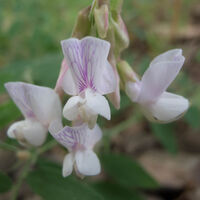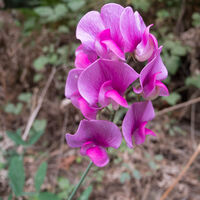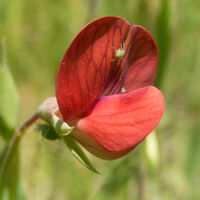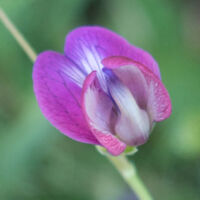sweet peas and vetchlings
genus Lathyrus
Member of
vetches vs. vetchlings
legume family (family Fabaceae)
dicots (class Magnoliopsida)
flowering plants (subphylum Angiospermae)
Except for historical records that I'm ignoring, there are no other wild species of this genus in the bay area.
Key features:
- number of flowers in inflorescence
- number of leaflets per leaf
- shape of tendril extending from leaf axis
- width of wings or angles on stem
- bristle extending on axis beyond flower
- length of calyx tube vs. lobes
See also vetches (genus Vicia) and chaparral pea (Pickeringia montana).
many flowers, many leaflets
Lathyrus jepsonii
- 6–15 flowers in inflorescence
- 10–16 leaflets per leaf
- leaf axis ends in branched, coiled tendril
- stem winged (wings ± ≥ 1 mm wide)
- corolla 15–20 mm, generally pink to pink-purple
- L. j. var. californicus is a smaller plant which is sometimes hairy.
- L. j. var. jepsonii can exceed two meters in height and is hairless, a rare variety which grows in the estuary habitat of the Sacramento-San Joaquin River Delta, the origin of the common name delta tule pea.
many flowers, two leaflets
one or two flowers
one flower, two leaflets
Lathyrus cicera
- 1 flower in inflorescence
- 2 leaflets per leaf
- stipules broad, lanceolate
- corolla 10–15 mm, red
- inflorescence axis terminates at flower pedicel
- calyx tube ≪ lobes
Toxicity of pea, everlasting; singletary pea; wild pea (Lathyrus spp.):
4 – Ingestion of these plants, especially in large amounts, is expected to cause serious effects to the heart, liver, kidneys or brain. If ingested in any amount, call the poison center immediately.
5 observed taxons / 7 unobserved taxons / 1 key
Locations: Months: For more details, use advanced search.
Chris’s observations: 89 (69 are research grade)
Taxon info: iNaturalist – Calflora – Jepson eFlora – FNA
Bay Area species: iNaturalist – Calflora




